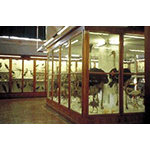Museo di Storia Naturale di Firenze - Sezione di Zoologia ("La Specola") [Museum of Natural History of Florence - Zoology Section ("La Specola")]
The "La Specola" Zoological Museum is still today located at the original venue of the Museum of Physics and Natural History from which it originated and with which it shared almost a century of history, that is until the division of the collections of the glorious Lorraine Museum among the various laboratories of the new Institute of Advanced Studies.
The Imperial and Royal Museum of Physics and Natural History was established in 1775 by Grand Duke of Tuscany Peter Leopold in the halls of Palazzo Torrigiani, and its direction was entrusted to abbot Felice Fontana. The idea was to give an organic and rational arrangement to the Medici scientific collections, formerly laid out along prevalently scenographic criteria in the Uffizi Gallery. In addition to the Medici objects, the rooms also exhibited newly-conceived instruments and anatomical waxes created in the Museum’s workshops. The institution also took on the shape of a modern research centre: it was equipped with experimental laboratories, a botanical garden, an astronomical observatory, a library and, as of 1807, a lyceum where sciences were taught. The Lyceum was made up of six scientific chairs (astronomy, physics, chemistry, comparative anatomy, mineralogy and zoology, and botany). There were no particular rules for admission to the lessons: no specific degree or diploma was required, and there was no enrolment fee to pay. The students did not have to pass examinations, and at the end of the courses, they could receive a private certificate from the professor, as no public diploma was provided for. Each teacher gave at least two lessons per week from the beginning of December until the end of August. At the end of every school year, a public session was held in which the teachers illustrated the discoveries and progress of the sciences, highlighting their practical applications. The courses were suppressed during the Restoration, and only resumed in 1833. After the end of the Grand Duchy of Tuscany, the Lyceum’s scientific experience was picked up by the natural sciences section of the Institute of Advanced Studies of Florence.
In 1841, a Tribune dedicated to Galileo Galilei was built in the palazzo. As of 1878, the Museum collections were divided up among the various sections of the new Institute of Advanced Studies: the "La Specola" Museum retained the anatomical waxes, the zoological collections and the scientific instruments; the latter were later assigned to the Institute and Museum of the History of Science.
Today’s Museum is known by the name of "La Specola", because the highest part of the building was the site of an astronomical observatory, which by age-old usage was called Specola (from the Latin specula, which means lookout, observatory). The rich and spectacular exhibition is organised in 33 rooms (22 for zoology, 10 for the waxes, 1 for temporary exhibitions) situated on the second floor of the building; the Hall of Skeletons on the ground floor is equipped with original nineteenth-century showcases.
The collection of anatomical waxes comprises works made between the late 18th and early 19th centuries, concerning Anatomy, both human and comparative, in addition to plaster casts and drawings. The Vertebrates collection includes specimens from the 18th 19th and 20th centuries, belonging to the 5 classes of Vertebrates: preparations under alcohol, taxidermic specimens, hides and skeletons. The collection of Invertebrates of the 19th and 20th centuries presents both dry specimens and exemplars under alcohol (models of Gastropod Molluscs with real shells and soft parts made of resin).
The library preserves valuable antique volumes and modern works. The Section’s archive includes the Giglioli archive (mainly epistolary), the Museum general archive from the late 19th century onward, and part of the archive of the Italian Entomological Society.
****************************
Texts by Graziano Magrini
English translation by Victor Beard
Last update 08/gen/2008




